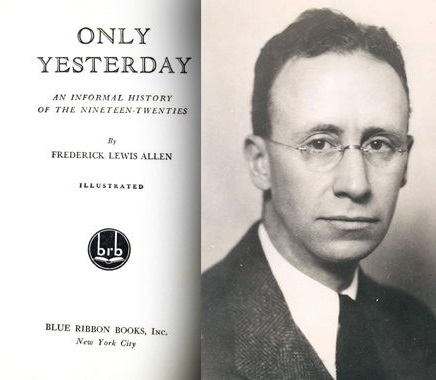|
| |
Fredrick Lewis Allen, Only Yesterday (1931)
Only Yesterday addresses the history of America from the First World War to after the Great Crash. Allen describes the economic boom of the 1920s in Chapter 7 (which you can read here, pages 215-241 – it is interesting easy-reading). It describes the new technology, mass-production and industrial growth; consumer culture: the automobile, radio and new consumer goods; the housing boom and stock market speculation … and why it all happened – including high-pressure salesmanship and advertising. His book interprets the Boom as a time of rapid change, unprecedented prosperity, huge optimism, and over-confidence in the almost-religion of ‘business’.
***
Some Quotes:“The Americans’ young country, with enormous resources in materials and in human energy and with a wide domestic market … had developed mass production to a new point of mechanical and managerial efficiency. The Ford gospel of high wages, low prices, and standardized manufacture on a basis of the most minute division of machine- tending labour was working smoothly in thousands of factories.” “Business itself was regarded with a new veneration … Indeed, the association of business with religion was one of the most significant phenomena of the day … So frequent was the use of the Bible to point the lessons of business and of business to point the lessons of the Bible that it was sometimes difficult to determine which was supposed to gam the most from the association.” “Prosperity was assisted by two new stimulants to purchasing, each of which mortgaged the future but kept the factories roaring. By the latter part of the decade, economists figured that 15% of all retail sales were on an installment basis, and that there were some $6 billions of “easy payment” paper outstanding. The other stimulant was stock-market speculation. When stocks were skyrocketing in 1928 and 1929 it is probable that hundreds of thousands of people were buying goods with money which represented, essentially, a gamble on the business profits of the nineteen-thirties.” "By the end of the decade, what a difference! – red and greenlights, blinkers, one-way streets, boulevard stops, parking ordinances — and a shining flow of traffic that backed up for blocks along Main Street every Saturday and Sunday afternoon." “As early as the end of 1923 there were two cars for every three families in a typical American city The Lynds and their investigators interviewed 123 working-class families and found that 60 of them had cars. Of these 60, 26 lived in such shabby-looking houses that the investigators thought to ask whether they had bathtubs, and discovered that as many as 21 of the 26 had none. The automobile came even before the tub!” “Mrs. Smith no longer patronized her “naborhood” store, she climbed into her two-thousand dollar car to drive to the red-fronted chain grocery and save twenty seven cents on her daily purchases.” “Behind those figures of radio sales lies a whole chapter of the life of the Post-war Decade, radio penetrating every third home in the country; giant broadcasting stations with nation-wide hook-ups; tenement-house roofs covered with forests of antennae; Rudy Vallee crooning from antique Florentine cabinet sets ; Graham McNamee’s voice, which had become more familiar to the American public than that of any other citizen of the land, shouting across your living-room and mine. “And he did it ! Yes, sir, he did it ' It’s a touchdown!” "The [advertiser] was learning to pay less attention to the special qualities and advantages of his product, and more to the study of what the mass of unregenerate mankind wanted — to be young and desirable, to be rich, to keep up with the Joneses, to be envied. The winning method was to associate his product with one or more of these ends.” “The Florida real-estate boom reached its dizziest height…. Everybody was making money on land, prices were climbing to incredible heights, and those who came to scoff remained to speculate.” “So the prosperity band-wagon rolled along with throttle wide open and siren blaring.”
|
Fredrick Lewis Allen was the editor-in-chief of the famous Harper’s Magazine, a biographer and historian of American society.
Only Yesterday has been criticised: Nathan Miller (2010) felt it had "certain defects" – it contains little hard data, and it "neglected blacks and the bitter labor struggles of the period". Nevertheless, modern American historians even today cite him as a useful source:
|
|
| |
